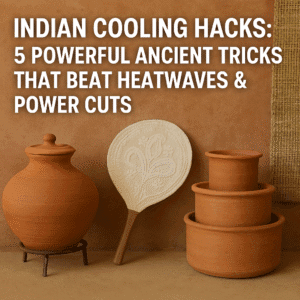Indian Cooling Hacks: 5 Powerful Ancient Tricks That Beat Heatwaves & Power Cuts
Before modern appliances, Indians relied on nature-smart techniques to beat the heat—methods that remain effective today. Clay pots (matkas) use evaporative cooling to chill water naturally, while handwoven chikankari fans offer portable relief without electricity. The mitti fridge, a double-layered clay pot with wet sand, keeps food fresh for days. Khus (vetiver) mats, when dampened, cool and fragrance incoming breezes, and breathable cotton clothing—like khadi and muslin—prevents overheating.
These sustainable, low-cost solutions not only combat rising temperatures but also support artisans and reduce energy dependence. In an era of climate challenges, revisiting these traditions isn’t just nostalgic—it’s a practical, eco-conscious choice. Try one today and experience the genius of India’s heat-beating heritage.

Indian Cooling Hacks: 5 Powerful Ancient Tricks That Beat Heatwaves & Power Cuts
As temperatures soar and power cuts become more frequent, many Indians are revisiting traditional ways to stay cool—methods that are sustainable, cost-effective, and surprisingly effective. Long before air conditioners and refrigerators, our ancestors relied on simple yet ingenious techniques to beat the heat.
Here are five timeless Indian cooling tricks that still work wonders today.
- The Magic of Clay Pots (Matka/ Ghada)
How It Works
Clay pots, or matkas, have been used for centuries to cool water naturally. The porous clay allows water to seep through slightly, and as it evaporates, it draws heat away, leaving the water inside refreshingly cool.
Why It’s Brilliant
✅ Zero electricity – No energy bills, just science.
✅ Gentler on the throat – Unlike fridge water, matka water is cool, not icy.
✅ Earthy taste – Many swear by the natural flavor.
How to Use It
- Keep a clay pot in a shaded, breezy spot.
- Change the water daily to prevent algae.
- Place it on a wooden or metal stand for better airflow.
- Handheld Chikankari Fans – Elegant & Effective
The Forgotten Art of Hand Fans
Before electric fans, handcrafted chikankari or palm-leaf fans were a staple in Indian homes. Made from cotton, bamboo, or khus grass, these fans provided instant relief with just a flick of the wrist.
Why They’re Still Useful
✅ Portable & silent – No batteries or noise.
✅ Supports artisans – Buying handmade helps preserve traditional crafts.
✅ Stylish & functional – A touch of old-world charm.
How to Use Them
- Keep one by your bedside or in your bag for power cuts.
- Opt for lightweight cotton or palm-leaf designs for better airflow.
- The Mitti Fridge – A Clay Cooler for Food
What Is It?
A zeer pot or mitti fridge consists of two earthen pots—one inside the other—with wet sand filling the gap. As the water evaporates, it cools the inner pot, keeping fruits, veggies, and dairy fresh.
Why It’s a Game-Changer
✅ Works without electricity – Perfect for rural areas or outages.
✅ Eco-friendly – No plastic, no emissions.
✅ Extends food shelf life – Can keep items cool for 1-2 days.
How to Try It
- DIY one with two clay pots and sand, or buy a ready-made version.
- Place it in a well-ventilated area and sprinkle water occasionally.
- Khus (Vetiver) Mats – Nature’s Air Cooler
How They Work
Khus mats, woven from vetiver grass roots, are hung over doors and windows. When sprinkled with water, they cool incoming air while releasing a soothing, earthy fragrance.
Why They Beat Artificial Coolers
✅ Lowers room temperature – Natural evaporative cooling.
✅ Aromatherapy benefits – Calms the mind and reduces stress.
✅ Reusable – Lasts for years with proper care.
How to Use Them
- Hang on windows or doorways where breeze enters.
- Lightly spray with water every few hours.
- Dressing Smart – The Power of Cotton & Loose Fits
Why Traditional Fabrics Win
Indian summers demand breathable clothing. Lightweight cotton, khadi, and muslin allow sweat to evaporate, keeping you cooler than synthetic fabrics.
Why It Matters More Than Ever
✅ Prevents heat rashes – Lets skin breathe.
✅ Sustainable choice – Reduces microplastic pollution.
✅ Supports weavers – Handloom cotton helps local artisans.
What to Wear
- Opt for loose kurtas, dhotis, or sarees in light colors.
- Avoid polyester and tight-fitting clothes.
These age-old techniques prove that staying cool doesn’t require high energy consumption. By blending tradition with modern needs, we can stay comfortable while reducing our carbon footprint.
You must be logged in to post a comment.